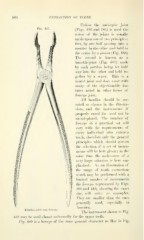Page 568 - My FlipBook
P. 568
566 EXTRACTION OF TEETH.
Unless the antiseptic joint
(Figs. 485 and 486) is used the
union of the joints is usually
made upon one of two })rineiples :
first, by one hall" passiug into a
mortise in the other and held in
tlie centre by a pinion (Fig. 488).
The second is known as a
knucklc-joiut (Fig. 487) made
by each portion being let half
way into the other and held to-
gether by a screw. This is a
neater joint and does away with
many of the objectionable fea-
tures noted in other forms of
forceps joint.
All handles should be ser-
rated as shown in the illustra-
tions, and the iustruments if
properly cared for need not be
nickel-plated. The number of
forceps in a practical set will
vary with the requirements of
every individual who extracts
teeth, therefore only the general
principles which should govern
the selection of a set of instru-
ments will be here given ; at the
same time the uselessness of a
verv larg-e selection is here em-
phasized. As an illustration of
the range of tooth extractions
which may be performed with a
limited number of instruments
the force})s represented by Figs.
488 and 489, shoAving the exact
size, Avill serve as examples.
They are smaller than the ones
generally used, especially in
America.
Knuckle-joint root forceps.
The instrument shown in Fig.
488 may be used almost universally for the up])er teeth.
Fig. 489 is a forceps of the same general character as that in Fig.


